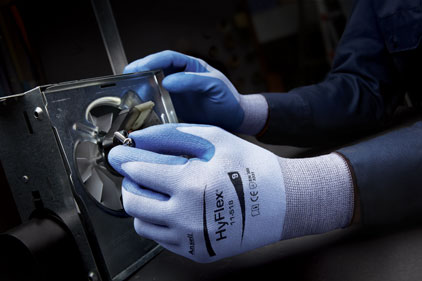Taking off the gloves: There's no reason for noncompliance

Taking gloves off during work used to be an unavoidable necessity for many workers. Today, however, innovations in fabrics, technology and production techniques are changing the hand protection experience for workers, providing incentive to wear work gloves for the duration of a shift. Consider the following three reasons workers tend to give for removing their gloves — and innovations which have stopped these excuses in their tracks:
1. “Gloves are not as comfortable as bare hands.”
Studies show that discomfort is the number one reason many workers remove hand protection. Gloves may be bulky and loose, hampering workers’ ability to perform job-related tasks or even getting caught in machinery. Improperly fitting hand protection may also restrict movement, causing hand fatigue, especially among older workers.
Comfort is essential for all applications, which is why more work gloves are now ergonomically designed to the shape of the hands, providing the flexibility required to perform tasks in fast-paced manufacturing environments. Innovative knitting technology varies the stitching in high stress areas — such as across the knuckles and back of the hand — to improve fit and allow hand movement for greater dexterity and less fatigue.
In the past, traditional hand protection products failed to manage perspiration and often resulted in wet, uncomfortable hands and persistent dermatitis, causing workers to remove their gloves. Employees at a chemical plant, for example, were unlikely to wear hand protection products for long periods during the summer when temperatures soared above 90ºF and their hands became hot and sweaty. Newer products are available that incorporate moisture management technology to significantly reduce perspiration build-up inside gloves in hot and humid environments.
Additionally, modern work gloves are breathable and keep hands cool and dry while protecting against job-related hazards such as cuts and abrasions.
2. “There’s no glove that provides all the protection that I need — and wearing multiple gloves at once just won’t cut it.”
In the past, many workers combined leather and heavy cotton gloves to provide protection against cut hazards. Or, they depended on multiple pairs of chemical-resistant gloves made of PVC or latex that were unable to breathe and offered little flexibility or provided limited protection against organic solvents.
Work gloves should always protect against the hazard that presents the greatest risk, whether it is cuts, abrasions, chemical burns or impact-related injuries. Luckily more gloves on the market today are designed for high levels of protection against multiple hazards such as cut and chemicals — while also being comfortable and improving workers’ ability to perform their jobs.
Some of today’s new technology includes a liquid-impermeable layer added to knit gloves to prevent oil or lubricants from making incidental contact with the wearer’s skin. Some cut-resistant gloves blend high performance polyethylene yarn with a polyurethane palm coating to provide ANSI Level 2 cut protection and ANSI Level 5 abrasion resistance. In addition, many gloves may be washed and re-used without reducing the cut protective properties, thereby extending the products’ service life.
Other state-of-the-art technology combines engineered, synthetic and natural fibers into high performance yarns to offer advanced levels of cut protection and dexterity. For example, a new hand protection product for the food industry combines advanced cut protection with spandex so the gloves conform to the hands and retain an ergonomic shape during use. In the past, an uncomfortable chain mesh glove was used to protect workers in high risk applications such as meat cutting. But today, with current innovations in hand protection, it often seems like anything is possible.
3. “I can’t work as fast with gloves on.”
In the past, heavy, bulky work gloves hampered hand movement and provided almost no sensitivity in the fingertips. As a result, workers often cut off the fingertips of their gloves or removed the product entirely to perform certain tasks, exposing fingers and hands to potential injury. In today’s world, however, workers who wear modern hand protection incorporating performance combined features such as dexterity and tactility are comfortable and productive.
Products are available today that offer an ultralight feel with flexibility, tactility and bare hand-like sensation. Special coatings can help keep hands cool and dry but at the same time offer ANSI Level 2 cut protection and ANSI Level 3 abrasion resistance to protect workers in assembly, packaging, machining and stamping applications.
Grip is a performance factor in many plant, oil field and construction applications. In order to securely grasp an object such as a pipe or sledge hammer, workers must have sufficient friction between the object and the hand. Workers often apply up to 40 percent more grip force than what they need to maintain a secure grasp. The grip force increases when objects are slippery due to oils or lubricants. Applying excessive grip force for a period of time can lead to hand and arm fatigue, which impacts performance. Over the long term, exerting excessive grip force can result in musculoskeletal disorders, including carpal tunnel syndrome. Microscopic channels used as a coating treatment in work gloves minimize the force required to maintain a firm grip on wet or oily objects and reduce hand and arm fatigue and improve dexterity. Current technology uses microscopic channels to wick away oil and moisture, thereby reducing the need for excessive grip force and the resulting fatigue.
Bottom-line benefits
Comfortable, productive workers save their employers money because they work faster and more confidently, which boosts productivity. Workers with comfortable gloves that provide sufficient protection and performance characteristics are unlikely to remove their hand protection, which helps control overall glove spend and glove loss. More important, injury rates decline, resulting in reduced medical indemnity costs and less time away from work.
Long-term success
Safety directors and purchasing personnel can ensure workers enjoy the above benefits by providing individuals the right glove for each application. Conducting a personal protective equipment (PPE) assessment will provide the opportunity to observe workers on the job and identify whether the gloves they are presently using provide the performance expected or need to be replaced. The assessment will also reveal whether workers wear hand protection for the duration of the shift.
To ensure that workers are compliant, they should receive training any time the company provides new hand protection products so they understand why they have new gloves, when and how they should be used, the product’s benefits and expected results. Glove boards, product use assessment and continued education can help ensure product acceptance and correct long-term use. With today’s technology and knowledge about hand protection, there is simply no reason not to keep gloves on.
TM and ® are trademarks owned by Ansell Limited or one of its affiliates. © 2013 Ansell Limited. All Rights Reserved.
Looking for a reprint of this article?
From high-res PDFs to custom plaques, order your copy today!





